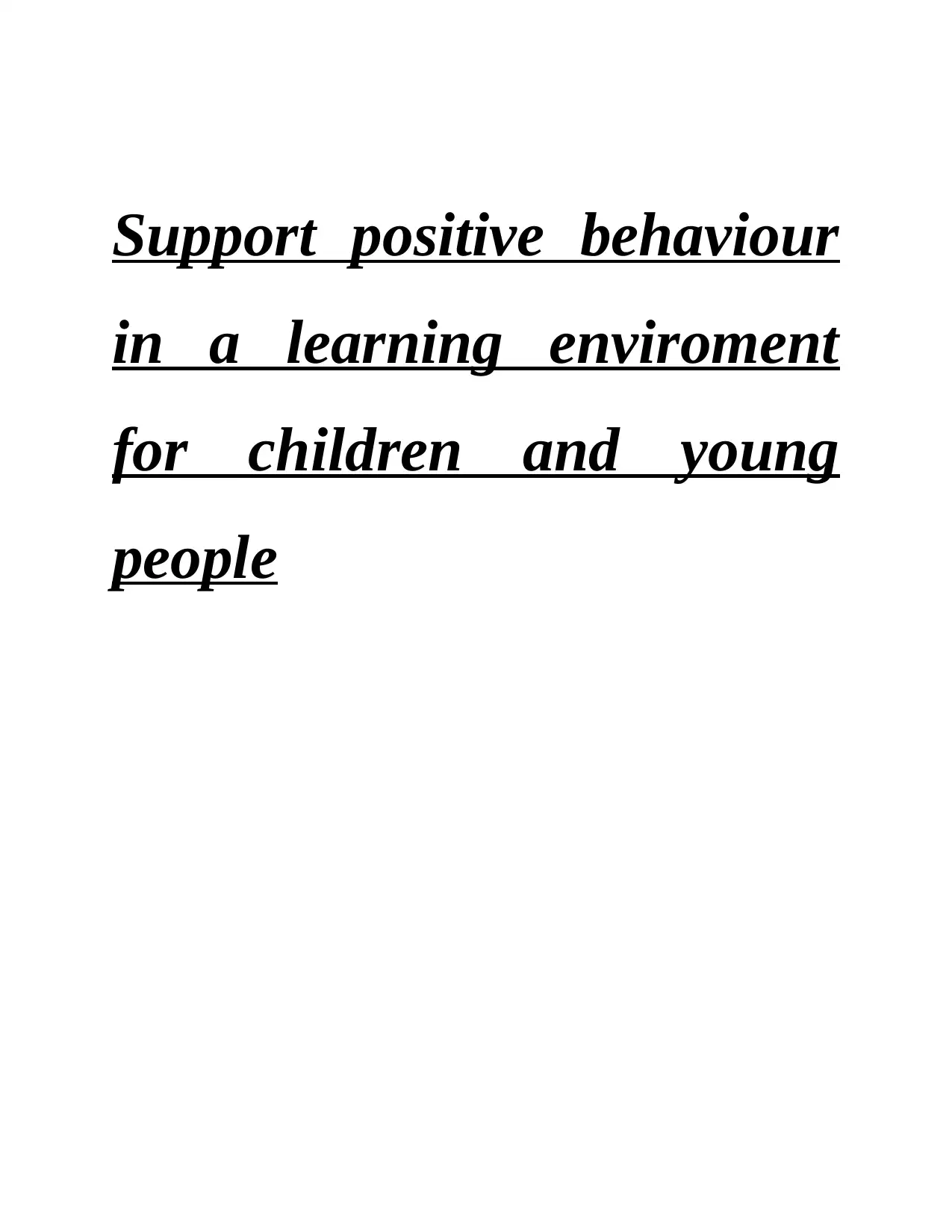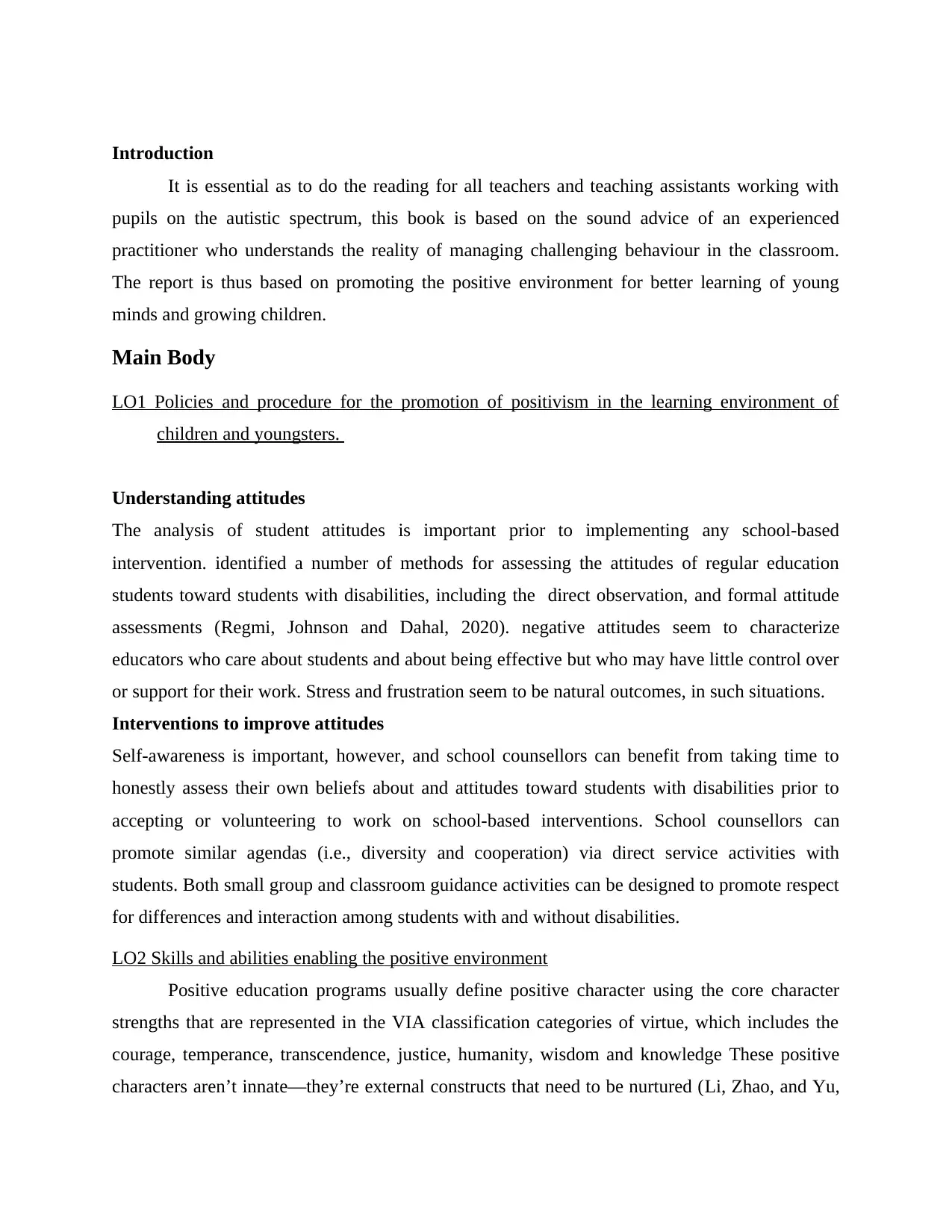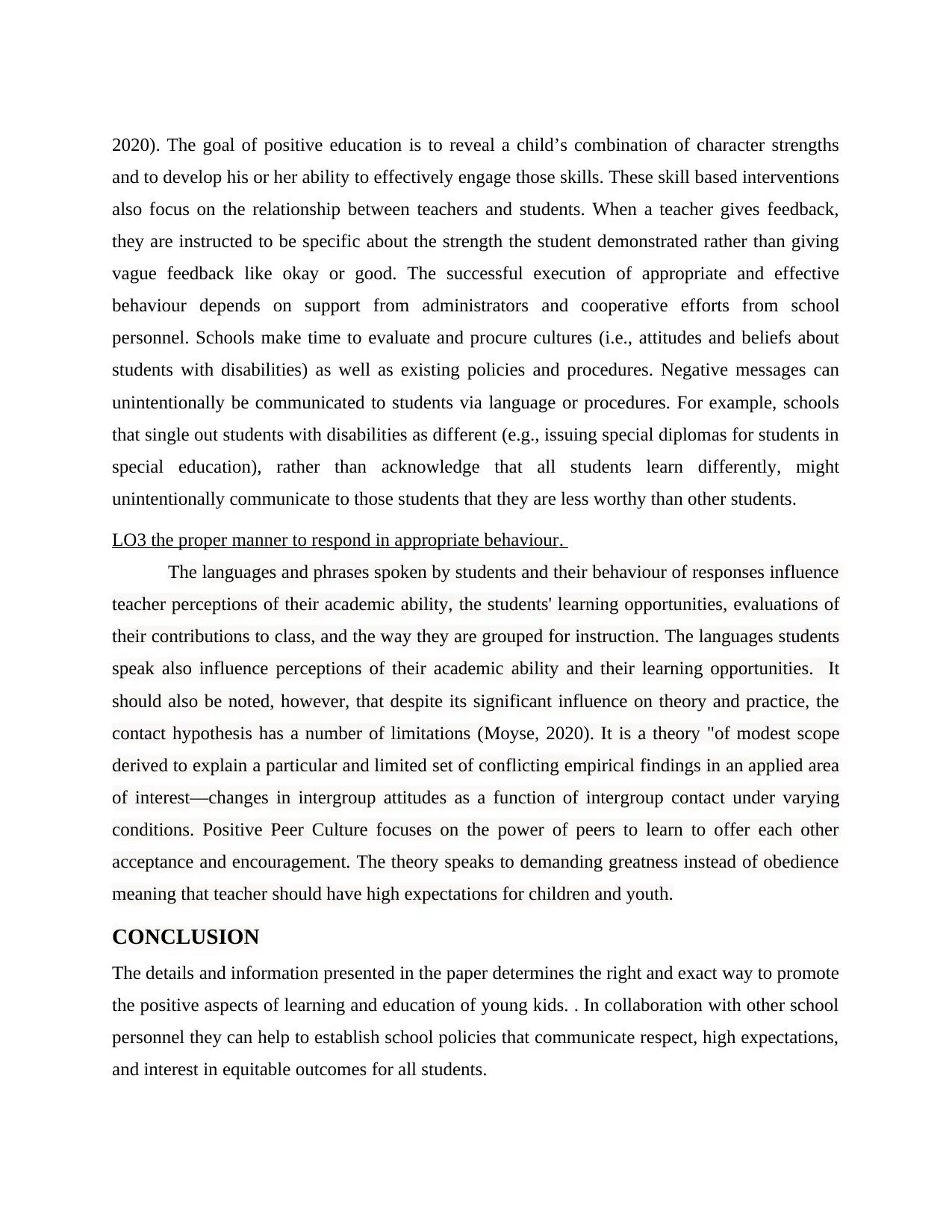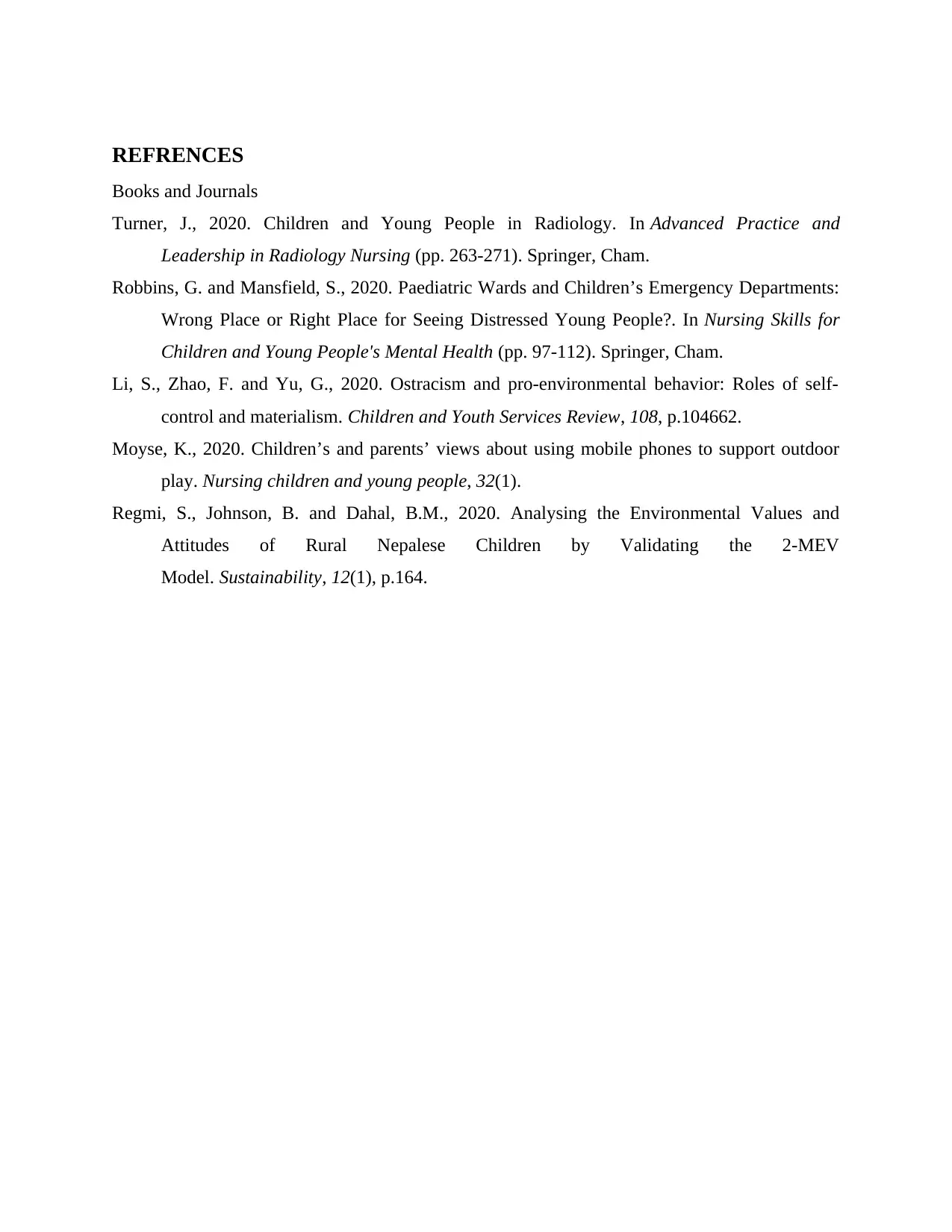Creating Positive Learning Environments for Children and Young People
VerifiedAdded on 2023/01/11
|5
|1019
|40
Report
AI Summary
This report explores strategies for promoting positive behavior in learning environments for children and young people. It covers policies and procedures for fostering a positive atmosphere, emphasizing the importance of understanding student attitudes and implementing interventions to improve them. The report highlights the skills and abilities necessary for creating a positive environment, including the development of character strengths and the role of teacher-student relationships. It also examines the appropriate responses to student behavior, including the influence of language and peer interactions. The report concludes by emphasizing the collaborative efforts needed from school personnel to establish policies that encourage respect and high expectations for all students. References include academic journals and books that support the findings and recommendations presented in the report.

Support positive behaviour
in a learning enviroment
for children and young
people
in a learning enviroment
for children and young
people
Paraphrase This Document
Need a fresh take? Get an instant paraphrase of this document with our AI Paraphraser

Table of Contents
Introduction......................................................................................................................................3
Main Body.......................................................................................................................................3
LO1 Policies and procedure for the promotion of positivism in the learning environment of
children and youngsters..........................................................................................................3
LO2 Skills and abilities enabling the positive environment..................................................3
LO3 The proper manner to respond in appropriate behaviour...............................................4
CONCLUSION................................................................................................................................4
REFRENCES...................................................................................................................................5
Introduction......................................................................................................................................3
Main Body.......................................................................................................................................3
LO1 Policies and procedure for the promotion of positivism in the learning environment of
children and youngsters..........................................................................................................3
LO2 Skills and abilities enabling the positive environment..................................................3
LO3 The proper manner to respond in appropriate behaviour...............................................4
CONCLUSION................................................................................................................................4
REFRENCES...................................................................................................................................5

Introduction
It is essential as to do the reading for all teachers and teaching assistants working with
pupils on the autistic spectrum, this book is based on the sound advice of an experienced
practitioner who understands the reality of managing challenging behaviour in the classroom.
The report is thus based on promoting the positive environment for better learning of young
minds and growing children.
Main Body
LO1 Policies and procedure for the promotion of positivism in the learning environment of
children and youngsters.
Understanding attitudes
The analysis of student attitudes is important prior to implementing any school-based
intervention. identified a number of methods for assessing the attitudes of regular education
students toward students with disabilities, including the direct observation, and formal attitude
assessments (Regmi, Johnson and Dahal, 2020). negative attitudes seem to characterize
educators who care about students and about being effective but who may have little control over
or support for their work. Stress and frustration seem to be natural outcomes, in such situations.
Interventions to improve attitudes
Self-awareness is important, however, and school counsellors can benefit from taking time to
honestly assess their own beliefs about and attitudes toward students with disabilities prior to
accepting or volunteering to work on school-based interventions. School counsellors can
promote similar agendas (i.e., diversity and cooperation) via direct service activities with
students. Both small group and classroom guidance activities can be designed to promote respect
for differences and interaction among students with and without disabilities.
LO2 Skills and abilities enabling the positive environment
Positive education programs usually define positive character using the core character
strengths that are represented in the VIA classification categories of virtue, which includes the
courage, temperance, transcendence, justice, humanity, wisdom and knowledge These positive
characters aren’t innate—they’re external constructs that need to be nurtured (Li, Zhao, and Yu,
It is essential as to do the reading for all teachers and teaching assistants working with
pupils on the autistic spectrum, this book is based on the sound advice of an experienced
practitioner who understands the reality of managing challenging behaviour in the classroom.
The report is thus based on promoting the positive environment for better learning of young
minds and growing children.
Main Body
LO1 Policies and procedure for the promotion of positivism in the learning environment of
children and youngsters.
Understanding attitudes
The analysis of student attitudes is important prior to implementing any school-based
intervention. identified a number of methods for assessing the attitudes of regular education
students toward students with disabilities, including the direct observation, and formal attitude
assessments (Regmi, Johnson and Dahal, 2020). negative attitudes seem to characterize
educators who care about students and about being effective but who may have little control over
or support for their work. Stress and frustration seem to be natural outcomes, in such situations.
Interventions to improve attitudes
Self-awareness is important, however, and school counsellors can benefit from taking time to
honestly assess their own beliefs about and attitudes toward students with disabilities prior to
accepting or volunteering to work on school-based interventions. School counsellors can
promote similar agendas (i.e., diversity and cooperation) via direct service activities with
students. Both small group and classroom guidance activities can be designed to promote respect
for differences and interaction among students with and without disabilities.
LO2 Skills and abilities enabling the positive environment
Positive education programs usually define positive character using the core character
strengths that are represented in the VIA classification categories of virtue, which includes the
courage, temperance, transcendence, justice, humanity, wisdom and knowledge These positive
characters aren’t innate—they’re external constructs that need to be nurtured (Li, Zhao, and Yu,
⊘ This is a preview!⊘
Do you want full access?
Subscribe today to unlock all pages.

Trusted by 1+ million students worldwide

2020). The goal of positive education is to reveal a child’s combination of character strengths
and to develop his or her ability to effectively engage those skills. These skill based interventions
also focus on the relationship between teachers and students. When a teacher gives feedback,
they are instructed to be specific about the strength the student demonstrated rather than giving
vague feedback like okay or good. The successful execution of appropriate and effective
behaviour depends on support from administrators and cooperative efforts from school
personnel. Schools make time to evaluate and procure cultures (i.e., attitudes and beliefs about
students with disabilities) as well as existing policies and procedures. Negative messages can
unintentionally be communicated to students via language or procedures. For example, schools
that single out students with disabilities as different (e.g., issuing special diplomas for students in
special education), rather than acknowledge that all students learn differently, might
unintentionally communicate to those students that they are less worthy than other students.
LO3 the proper manner to respond in appropriate behaviour.
The languages and phrases spoken by students and their behaviour of responses influence
teacher perceptions of their academic ability, the students' learning opportunities, evaluations of
their contributions to class, and the way they are grouped for instruction. The languages students
speak also influence perceptions of their academic ability and their learning opportunities. It
should also be noted, however, that despite its significant influence on theory and practice, the
contact hypothesis has a number of limitations (Moyse, 2020). It is a theory "of modest scope
derived to explain a particular and limited set of conflicting empirical findings in an applied area
of interest—changes in intergroup attitudes as a function of intergroup contact under varying
conditions. Positive Peer Culture focuses on the power of peers to learn to offer each other
acceptance and encouragement. The theory speaks to demanding greatness instead of obedience
meaning that teacher should have high expectations for children and youth.
CONCLUSION
The details and information presented in the paper determines the right and exact way to promote
the positive aspects of learning and education of young kids. . In collaboration with other school
personnel they can help to establish school policies that communicate respect, high expectations,
and interest in equitable outcomes for all students.
and to develop his or her ability to effectively engage those skills. These skill based interventions
also focus on the relationship between teachers and students. When a teacher gives feedback,
they are instructed to be specific about the strength the student demonstrated rather than giving
vague feedback like okay or good. The successful execution of appropriate and effective
behaviour depends on support from administrators and cooperative efforts from school
personnel. Schools make time to evaluate and procure cultures (i.e., attitudes and beliefs about
students with disabilities) as well as existing policies and procedures. Negative messages can
unintentionally be communicated to students via language or procedures. For example, schools
that single out students with disabilities as different (e.g., issuing special diplomas for students in
special education), rather than acknowledge that all students learn differently, might
unintentionally communicate to those students that they are less worthy than other students.
LO3 the proper manner to respond in appropriate behaviour.
The languages and phrases spoken by students and their behaviour of responses influence
teacher perceptions of their academic ability, the students' learning opportunities, evaluations of
their contributions to class, and the way they are grouped for instruction. The languages students
speak also influence perceptions of their academic ability and their learning opportunities. It
should also be noted, however, that despite its significant influence on theory and practice, the
contact hypothesis has a number of limitations (Moyse, 2020). It is a theory "of modest scope
derived to explain a particular and limited set of conflicting empirical findings in an applied area
of interest—changes in intergroup attitudes as a function of intergroup contact under varying
conditions. Positive Peer Culture focuses on the power of peers to learn to offer each other
acceptance and encouragement. The theory speaks to demanding greatness instead of obedience
meaning that teacher should have high expectations for children and youth.
CONCLUSION
The details and information presented in the paper determines the right and exact way to promote
the positive aspects of learning and education of young kids. . In collaboration with other school
personnel they can help to establish school policies that communicate respect, high expectations,
and interest in equitable outcomes for all students.
Paraphrase This Document
Need a fresh take? Get an instant paraphrase of this document with our AI Paraphraser

REFRENCES
Books and Journals
Turner, J., 2020. Children and Young People in Radiology. In Advanced Practice and
Leadership in Radiology Nursing (pp. 263-271). Springer, Cham.
Robbins, G. and Mansfield, S., 2020. Paediatric Wards and Children’s Emergency Departments:
Wrong Place or Right Place for Seeing Distressed Young People?. In Nursing Skills for
Children and Young People's Mental Health (pp. 97-112). Springer, Cham.
Li, S., Zhao, F. and Yu, G., 2020. Ostracism and pro-environmental behavior: Roles of self-
control and materialism. Children and Youth Services Review, 108, p.104662.
Moyse, K., 2020. Children’s and parents’ views about using mobile phones to support outdoor
play. Nursing children and young people, 32(1).
Regmi, S., Johnson, B. and Dahal, B.M., 2020. Analysing the Environmental Values and
Attitudes of Rural Nepalese Children by Validating the 2-MEV
Model. Sustainability, 12(1), p.164.
Books and Journals
Turner, J., 2020. Children and Young People in Radiology. In Advanced Practice and
Leadership in Radiology Nursing (pp. 263-271). Springer, Cham.
Robbins, G. and Mansfield, S., 2020. Paediatric Wards and Children’s Emergency Departments:
Wrong Place or Right Place for Seeing Distressed Young People?. In Nursing Skills for
Children and Young People's Mental Health (pp. 97-112). Springer, Cham.
Li, S., Zhao, F. and Yu, G., 2020. Ostracism and pro-environmental behavior: Roles of self-
control and materialism. Children and Youth Services Review, 108, p.104662.
Moyse, K., 2020. Children’s and parents’ views about using mobile phones to support outdoor
play. Nursing children and young people, 32(1).
Regmi, S., Johnson, B. and Dahal, B.M., 2020. Analysing the Environmental Values and
Attitudes of Rural Nepalese Children by Validating the 2-MEV
Model. Sustainability, 12(1), p.164.
1 out of 5
Related Documents
Your All-in-One AI-Powered Toolkit for Academic Success.
+13062052269
info@desklib.com
Available 24*7 on WhatsApp / Email
![[object Object]](/_next/static/media/star-bottom.7253800d.svg)
Unlock your academic potential
Copyright © 2020–2025 A2Z Services. All Rights Reserved. Developed and managed by ZUCOL.




